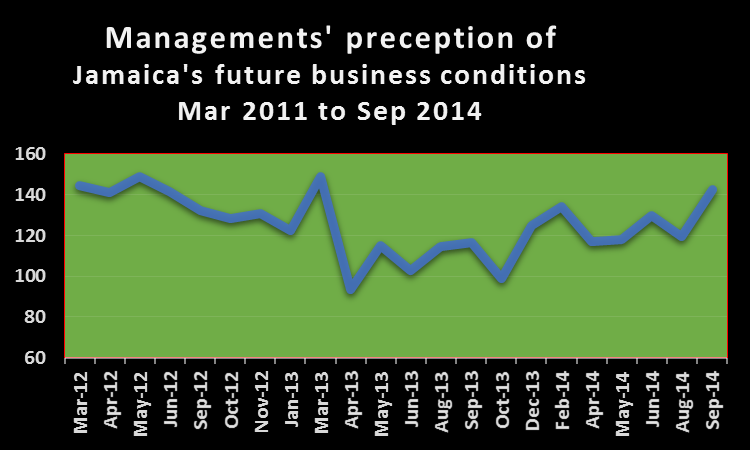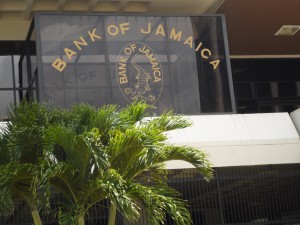 Jamaica has to rely on the private sector, to help lift it from the economic quagmire it finds itself in, for the past 3 decades. A look at certain data shed some light on the task the country faces.
Jamaica has to rely on the private sector, to help lift it from the economic quagmire it finds itself in, for the past 3 decades. A look at certain data shed some light on the task the country faces.
It tells of a nation where the business sector leaders seem to be managing more from the seat of their pants than based on properly informed position. Take the case of inflation, which ran at 5.1 percent up to August, for 2014, for an average of just less than 0.68 percent per month, and against the back ground of slippage in the exchange rate in the early months that would have helped spike inflation then. With an almost stable Jamaican dollar in September a survey done by the Statistical Institute of Jamaica on behalf of the Bank of Jamaica to ascertain the expectations of Chief Executive Officers, Managing Directors and Financial Controllers about the future movement of prices in September this year, to which 270 responded, found that their expectation for inflation for 2014, will end at 10.2 percent. On what basis is they arrive at this forecasted amount.
Interestingly, the official inflation rate to October is 7.3 percent, the full year’s figure should hoover around this level with the price of oil on the world market having declined sharply, pulling some local cost down with it.
The business sector record on business confidence both on the current state as well as a year out has no better record as ca be seen from the wild fluctuation in the periodic results.
On the matter of Treasury bill rate, while rates have been declining monthly from a peak in March, this year. The survey respondents expected the rate for the 182 day Treasury bill to come out at 8.6 percent at a time the rate had already declined to 8 percent. Admittedly, the interest rate forecast is not totally inconsistent with the managerial group inflation forecast, as investors would want to be compensated with an interest rates above the inflation as they see it. But if the inflation rate forecasted is as high as the private sector figures there would also be need for a greater slippage in the rate of exchange for the Jamaican dollar versus the US dollar. Yet their perception that the exchange rate would slip by 1.3 percent by the end of 2014 from September, would not be in keeping with the high inflation rate they projected.
Treasury-bill rates continue down
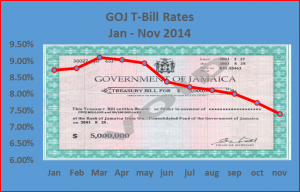 The latest results for Government of Jamaica Treasury bill auctions, show a decline in the interest rate on 28 days instrument, to 6.71 percent from 6.826 percent in October, as $976 million chased the $400 million on offer.
The latest results for Government of Jamaica Treasury bill auctions, show a decline in the interest rate on 28 days instrument, to 6.71 percent from 6.826 percent in October, as $976 million chased the $400 million on offer.
Investors, demand for the 91 days Treasury bills offered continued to climb, jumping to $1.042 billion, up from $903,521,900 for the October auction and well up on September’s $641,904,600. Demand for the longer-term 182 days instrument, was for $942 million for the latest auction in which the amounts available was $400 million for all three Treasury bills on offer.
The Treasury bill for the 91 day period, Friday, November 21 to mature on Friday, February 20 next year, attracted an average yield of 7.052 percent, down from 7.336 percent in October, 7.46952 percent, at the September auction. At the August auction the average rate out turn was 7.46767 percent. The yield for July was an average of 7.63643 percent, for the June issue 7.65893 percent and 8.2 percent in May, for the Treasury bill of same duration.
The offer of 182 days duration, maturing on May 22 next year, generates an average interest rate yield of 7.387 percent, a decline from 7.73187 percent, 7.99887 percent, at the September auction, 8.11578 percent, in August, 8.21982 percent at the July’s auction and 8.36502 percent for the June issue, of the same duration. At the May Treasury bill auction, the rate came out at 8.932 percent.
Record take – Jamaica’s remittances
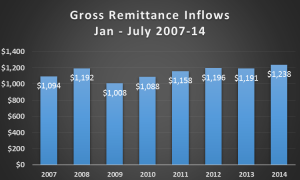 Jamaica enjoyed record inflows of remittances, between January and July this year. The critically important flow of funds, reached $1.238 billion, representing an increase of US$47.6 million or 4 percent to be the highest inflows ever, according to the latest data on remittances, released by the country’s central bank.
Jamaica enjoyed record inflows of remittances, between January and July this year. The critically important flow of funds, reached $1.238 billion, representing an increase of US$47.6 million or 4 percent to be the highest inflows ever, according to the latest data on remittances, released by the country’s central bank.
The 2014 inflows, bettered the previous high of US$1.195 billion, in 2012 and the next highest, $1.192 billion in 2008. Net remittances for 2014 to-date, is US$1.109 billion, a growth of US$61 million or 5.8 percent relative to 2013. The out-turn for the period reflects an increase in gross inflows and a reduction in outflows.
Net remittances for July this year were US$160.5 million, an increase of US$10.9 million or 7.3 percent over the July 2013. The growth in net remittance inflows reflect an increase in gross remittance, which was partially offset by an expansion in remittance outflows.
Gross remittance inflows for the month were US$183.2 million, an increase of US$12.6 million or 7.4 percent compared to July 2013.
Jamiaca’s exports to Caricom up
 Jamaica’s total exports to CARICOM for the January to July 2014 period increased by US$7.5 million or 17.8 per cent to US$50 million compared to the 2013 period.
Jamaica’s total exports to CARICOM for the January to July 2014 period increased by US$7.5 million or 17.8 per cent to US$50 million compared to the 2013 period.
Imports from CARICOM region same period declined by 4.4 percent or US$21.4 million to US$468.4 million as were lower imports of Mineral Fuels, in July 2014. Mineral Fuels, declined by 1.8 percent or US$5.7 million to US$317 million for the seven months. Food fell by 12.8 percent or US$12.6 million to US$85.8 million, Beverages & Tobacco by 10.1 percent and Manufactured Goods moved from US$13.3 million to US$12.8 million. Imports of Chemicals however rose by 5.9 percent or US$1 million to US$16.7 million.
At the end of January to July 2014, Jamaica incurred a trade deficit of US$418.5 million with her CARICOM partners which was below the US$447.4 million in the comparable 2013 period.
Jamiaca Exports fall
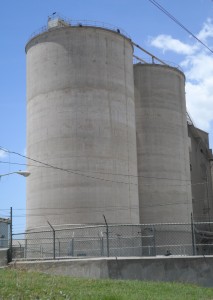 Jamaica’s domestic exports for the first seven months of 2014, declined compare with the similar period in 2013.
Jamaica’s domestic exports for the first seven months of 2014, declined compare with the similar period in 2013.
Traditional exports earned US$453 million during the period falling by 5.3 percent or US$25.6 million below the amount recorded during the 2013 period. Mining and Quarrying earned US$368 million as the major commodity Alumina recorded lower earnings in the 2014 period. Agriculture was valued at a mere US$12.8 million and Manufacture US$72.3 million.
In the 2014 review period Non-traditional domestic exports during the January to July 2014 period accounted for 44.3 percent of domestic exports but total earnings for the newer export items fell by US$91 million or 20.2 percent to US$360 million. reduction of ethanol would have been one of the major factor for the lower export earnings as world market prices were not conducive for the production of this fuel.
Jamaica’s imports drop
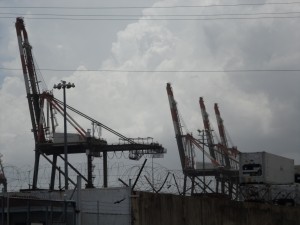 Jamaica’s imports of Raw Materials and Intermediate Goods for the period to July this year, declined by 6.7 percent or US$151 million to US$2.1125 billion Other Fuel and Lubricants fell by US$4.3 million to US$724 million.
Jamaica’s imports of Raw Materials and Intermediate Goods for the period to July this year, declined by 6.7 percent or US$151 million to US$2.1125 billion Other Fuel and Lubricants fell by US$4.3 million to US$724 million.
Industrial Supplies, declined by 12.2 percent or US$75.6 million to US$544 million. Food and beverages fell, moving down by US$28.6 million or 14.1 percent to US$174 million due to lower importation of corn, wheat and rice. Capital Goods grew by 5.8 percent or US$9 million to US$167 million. Expenditure on Consumer Goods (excl. Motor Cars) increased by 8.2 percent or US$72 million to US$945.7 million during the first seven months of 2014 period.
Imports could decline further with the price of oil on the world market having fallen to the US$80 range since the July report was released.
Drop in export pushes up Jamaica’s trade deficit
 Jamaica’s trade deficit during the first seven months of 2014, deteriorated compared to the same period last year. The worsening position occurred as a result of a sharp fall in non-traditional exports, rather than increased imports.
Jamaica’s trade deficit during the first seven months of 2014, deteriorated compared to the same period last year. The worsening position occurred as a result of a sharp fall in non-traditional exports, rather than increased imports.
The deficit ended at US$2.613 billion, compared to US$2.573 billion in the comparable period for 2013. The deterioration flowed from merchandise imports during the 7 months, valued at US$3.47 billion, decreasing by 2.4 percent or US$86 million, compared to the $3.55 billion recorded in the similar 2013 period. On the other hand, exports for the 2014 period, amounted to US$852 million, a decline of 12.9 percent or US$127 million below the US$979 million earned in the similar 2013 period.
Imports| According to the Statistical Institute of Jamaica (Statin), the decline in imports was largely influenced by lower spending on importation of Mineral Fuels, Chemicals, Beverages & Tobacco.
Exports fall| During the first seven months to July, traditional exports earned US$453 million, falling by 5.3 percent or US$25.6 million below the exports earnings during the 2013 period. Non-traditional export earnings from January to July 2014, fell by US$91 million or 20.2 percent, to US$360 million.
